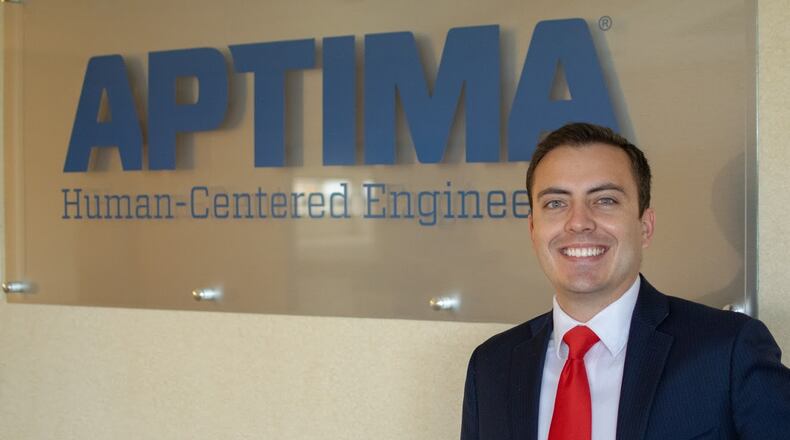Aptima was founded in 1995 in Woburn, Mass., but established a Dayton-area presence in about 2007, drawn in part by the creation of the 711th Human Performance Wing at Wright-Patterson Air Force Base. By 2013, the wing was one of the company’s biggest customers. And Aptima continues to work with the Air Force Research Lab, also at Wright-Patterson, to measure performance and stress in warfighters, such as pilots.
Sentinel’s new technology isn’t actually new. Some five years in the making, it employs sensors and software and has been reconstituted into a system that monitors workers in hazardous settings.
The product is called “SafeGuard.”
Zach Kiehl, Sentinel’s chief executive and president, said SafeGuard was borne of hours of work with the Air Force and elsewhere, devising a way to monitor worker safety.
SafeGuard offers a “Internet of Things” approach, combining sensors, wearable belts and monitors with data analytics, to keep tabs on workers in dangerous settings.
The idea is to detect and alert workers to problems with time to spare.
The innovation enables cloud-based monitoring, letting one safety manager oversee the real-time health and safety of up to about 15 workers simultaneously, Kiehl said.
The innovation allows tracking workers’ precise locations in GPS denied environments.
“It has been going really well,” Kiehl said. “I should say SafeGuard is still being worked on, so we are still very much at the customer-discovery, customer-acquisition phase.”
The product works, Kiehl said, but trials are offering further refinements and opportunities to answer questions from prospective customers.
Backing from the Air Force has been crucial, providing $6 million to $8 million of government support over the last five years to address a particular Air Force use case.
“But with Sentienel and SafeGuard, we realized that there was a lot of commercial potential as well,” the CEO said. “So we’re rapidly trying to integrate into the commercial sector and see if there’s a product market there.”
The Air Force continues to be a partner.
“The Air Force Research Laboratory ... they really push the state of the art and offer the Dayton area a lot of innovation,” Kiehl said.
Accelerant, the Dayton Development Coalition’s $9.1 million, 10-year seed-stage venture fund, is an investor in Sentinel, providing further support.
Dr. Rajesh Naik, the chief scientist at the 711th Human Performance Wing, which is part of AFRL, said this is a crucial area for the Air Force, which needs systems to monitor the safety and health of pilots and warfighters.
The service has studied systems like SafeGuard in cockpits to monitor the physiological status of aircrews, on flight lines, watching over people working in confined spaces, who may be exposed to toxic fumes or other hazards.
It also has applications in situations where worksites need to watch for the onset of COVID-19 symptoms, Naik said.
Naik has watched this technology from its early inception.
“It allows us to provide an additional layer of safety and health monitoring of our folks here,” he said, while adding that he was not explicitly endorsing the product.
Still, the partnership with industrial and private companies is worth noting, he added.
“I think the beauty of it ... is the collaboration,” he said. “The successful partnership that we’ve had with labs, with industrial partners all coming together. That’s also something I think worth highlighting.”
About the Author




